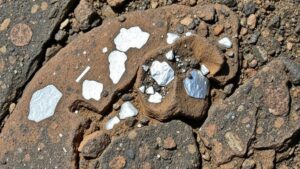Spotting Stream Junctions Where Heavy Minerals Accumulate
Spotting Stream Junctions Where Heavy Minerals Accumulate
Identifying stream junctions is crucial to understanding where heavy minerals tend to gather, as these areas often serve as natural concentrators of valuable resources. By analyzing fluid dynamics and sediment transport mechanisms, geologists and mineralogists can effectively pinpoint spots for mineral exploration.
The Fundamentals of Stream Junctions
A stream junction occurs when two or more streams converge. This interaction creates a complex flow dynamic that can significantly affect sediment deposition. velocity of water changes as it merges, leading to a reduction in transporting capacity, which allows heavier particles to settle.
At junctions, three main types of sedimentation processes can occur:
- Hydraulic Sorting: As water slows down, it loses energy and separates materials according to size and density.
- Deposition: Heavy minerals such as gold, cassiterite, and magnetite tend to settle out of suspension at these confluences due to their high specific gravity.
- Braidplain Formation: In braided streams, sediment is often reworked and can lead to layers of different sediment mixes forming along the junctions.
Characteristics of Heavy Minerals
Heavy minerals are generally defined as those having a specific gravity greater than 2.9 g/cm³. This group primarily includes minerals like zircon, ilmenite, and monazite. Understanding their characteristics aids in identifying potential accumulation zones at stream junctions.
Key characteristics of heavy minerals include:
- Durability: They resist weathering and can remain intact during transportation.
- High Density: Their weight helps them settle in lower energy environments.
- Sparse Distribution: They often constitute only a small percentage of the sediment, making their detection essential but challenging.
Field Techniques for Identifying Junctions
Several field techniques can be employed to spot stream junctions where heavy minerals are likely deposited:
- Hydrophobic Sampling: Collecting sediment samples during low water may reveal patterns and concentrations of heavy minerals.
- Geophysical Surveys: Methods such as ground-penetrating radar (GPR) can help identify sediment structures below the surface.
- Stream Gauge Monitoring: Analyzing variations in stream flow can indicate where sediments are likely to settle.
Case Studies and Real-World Applications
Various practical applications illustrate how recognizing stream junctions impacts mineral exploration:
- A Case Study in Brazilian Gold Mining: In the Amazon Basin, miners have utilized the knowledge of stream junctions to target regions in previously unexplored areas, leading to increased yields of gold nuggets.
- Ilmenite Extraction in Australia: The Murray Rivers wide junctions have been crucial in the effective extraction of ilmenite by understanding sediment flow and accumulation patterns.
Challenges and Future Considerations
Despite the effectiveness of current methods, challenges remain. Sediment transport can be highly variable and influenced by factors like rainfall, upstream mining activities, and human-induced changes such as dam construction. As a result, understanding local hydrology is critical.
Future research utilizing technologies such as computational fluid dynamics (CFD) could refine our understanding of sediment dynamics at stream junctions. Plus, integrating environmental monitoring with mineral exploration practices makes sense for sustainable resource management.
Actionable Takeaways
For professionals interested in mineral exploration, key strategies include:
- Utilizing field techniques discussed to collect data on stream junctions and sediments.
- Collaborating with hydrologists or geophysicists to enhance understanding of local sediment dynamics.
- Incorporating advanced technologies to predict sediment behavior and optimize exploration effectiveness.
By combining detailed field studies with advanced technological methods, opportunities for discovering heavy minerals in stream junctions can significantly improve, leading to sustainable and economically viable extraction practices.


